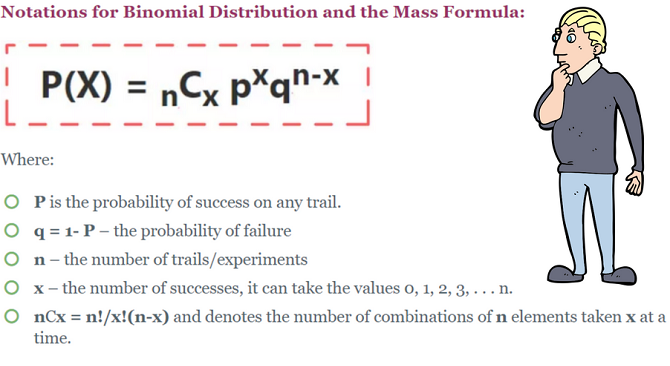Imagine tossing a coin repeatedly. What’s the probability of getting exactly three heads in ten flips? This seemingly simple scenario is a perfect example of a binomial distribution, a powerful tool for analyzing events with binary outcomes.

Image: criticalthinking.cloud
This article delves into the fascinating world of binomial distribution, offering clear explanations, real-world examples, and a downloadable PDF guide packed with solutions. Whether you’re a student grappling with probability concepts or a professional seeking to understand data patterns, this comprehensive guide will equip you with the knowledge to confidently navigate binomial distribution problems.
What is Binomial Distribution?
In essence, binomial distribution models the probability of a specific number of successes in a fixed number of independent trials, where each trial has only two possible outcomes: success or failure. Think of it as a way to understand the likelihood of specific results in situations where there are only two possibilities.
Key Components of Binomial Distribution
1. Fixed Number of Trials (n)
This represents the total number of times an experiment is conducted. In our coin toss example, n = 10, as we flip the coin ten times.

Image: ainxt.co.in
2. Probability of Success (p)
This is the probability of achieving a “success” in a single trial. For a fair coin, the probability of getting heads (success) is p = 0.5.
3. Independence of Trials
Each trial must be independent of the others; the result of one trial does not influence the results of any other. This is crucial for accurately applying the binomial distribution formula.
The Binomial Formula
The formula used to calculate the probability of achieving exactly *k* successes in *n* trials is:
P(X = k) = (nCk) * p^k * (1-p)^(n-k)
Where:
- P(X = k) represents the probability of obtaining exactly *k* successes.
- (nCk) represents the binomial coefficient, which calculates the number of ways to choose *k* items from a set of *n* items. This can be calculated as n! / (k! * (n-k)!).
- p^k is the probability of success raised to the power of *k*.
- (1-p)^(n-k) is the probability of failure raised to the power of (n-k).
Examples and Solutions
Example 1: Coin Tosses
Let’s revisit our coin toss example. What is the probability of obtaining exactly three heads in ten flips?
Here, n = 10, k = 3, p = 0.5.
Applying the formula:
P(X = 3) = (10C3) * 0.5^3 * (1 – 0.5)^(10 – 3)
P(X = 3) = (10! / (3! * 7!)) * 0.125 * 0.078125
P(X = 3) ≈ 0.1172
Therefore, the probability of getting exactly three heads in ten coin flips is approximately 11.72%.
Example 2: Defective Products
Imagine a factory producing light bulbs, with a 2% defect rate. If you randomly select 50 bulbs, what is the probability of finding exactly two defective bulbs?
Here, n = 50, k = 2, p = 0.02.
Applying the formula:
P(X = 2) = (50C2) * 0.02^2 * (1 – 0.02)^(50 – 2)
P(X = 2) ≈ 0.185
The probability of finding exactly two defective bulbs in a sample of 50 is approximately 18.5%.
Real-World Applications
Binomial distribution finds applications in diverse fields, including:
- Quality Control: Evaluating the probability of defective products in a batch.
- Healthcare: Studying the effectiveness of treatments and the probability of disease occurrence.
- Finance: Analyzing investment returns and the likelihood of market fluctuations.
- Marketing: Predicting customer responses to campaigns and gauging the success of promotional strategies.
Limitations of Binomial Distribution
It’s crucial to understand that binomial distribution has limitations:
- Fixed Number of Trials: It only works when the number of trials is predetermined.
- Independent Trials: The outcomes of each trial must be independent of each other.
- Constant Probability: The probability of success needs to remain consistent throughout all trials.
Important Considerations for Applying Binomial Distribution
When tackling problems involving binomial distribution, remember to consider:
- Define Success: Clearly identify what constitutes a “success” in your scenario.
- Determine n and p: Identify the number of trials and the probability of success accurately.
- Interpret Results: Understand the meaning of the calculated probabilities and their implications.
Beyond the Basics
This article provides a foundation for understanding binomial distribution. For further exploration, consider delving into:
- Cumulative Binomial Distribution: This calculates the probability of obtaining at least or at most a certain number of successes.
- Binomial Confidence Intervals: Estimating the range of possible success probabilities based on sample data.
- Hypothesis Testing: Using binomial distribution to test hypotheses about population proportions.
Your Guide to Binomial Distribution – Download Your PDF
To solidify your understanding and equip yourself with practical tools, download our exclusive PDF guide. It contains detailed examples, step-by-step solutions, and a comprehensive overview of crucial concepts. This resource will empower you to solve binomial distribution problems with confidence.
Click here to download your [Binomial Distribution Example Solutions PDF](link to your PDF)
Binomial Distribution Examples And Solutions Pdf
Conclusion
Binomial distribution is a powerful tool for analyzing events with binary outcomes, offering valuable insights into probability and data patterns. By understanding its core concepts, formula, and applications, you gain a powerful framework for solving problems in various fields. Embrace the opportunity to learn more, explore related topics, and consider the practical implications of this essential statistical concept.





